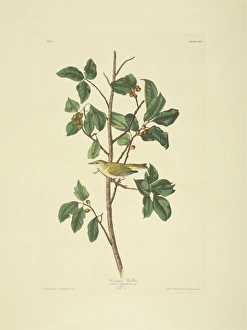Leiothlypis Peregrina Collection
The Tennessee Warbler, scientifically known as Leiothlypis peregrina
All Professionally Made to Order for Quick Shipping
The Tennessee Warbler, scientifically known as Leiothlypis peregrina, is a small migratory songbird that captivates bird enthusiasts with its vibrant plumage and melodic songs. This charming species, often spotted during the breeding season in North America's boreal forests, has become a symbol of beauty and resilience. With its olive-green back and yellowish underparts, the Tennessee Warbler stands out among its feathered counterparts. Its striking appearance is further enhanced by subtle streaks on its breast and sides. As it flits through the trees in search of insects to feed on, this warbler's agile movements are a sight to behold. During migration periods, these birds embark on an incredible journey from their breeding grounds in Canada to their wintering grounds in Central America or northern South America. Their long-distance flights showcase their determination and adaptability as they navigate vast distances across various habitats. Apart from its physical attributes, the Tennessee Warbler also possesses a melodious voice that echoes through the forest canopy. Its sweet trills and high-pitched notes add harmony to nature's symphony. Birdwatchers eagerly await springtime when these tiny creatures return from their tropical sojourns to serenade us with their enchanting tunes. Conservation efforts play a crucial role in preserving the habitat of Leiothlypis peregrina. Deforestation poses significant threats to this species' survival as it relies heavily on intact boreal forests for nesting and foraging purposes. By protecting these vital ecosystems, we can ensure that future generations will continue to marvel at the beauty of the Tennessee Warbler. So next time you find yourself surrounded by nature's tranquility or exploring dense woodlands, keep an eye out for this delightful traveler -the Tennessee Warbler- whose presence reminds us of both our interconnectedness with wildlife and our responsibility towards conservation efforts.

